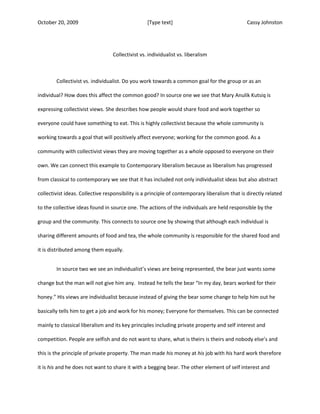
Perspectives On Ideology
- 1. Collectivist vs. individualist vs. liberalism<br />Collectivist vs. individualist. Do you work towards a common goal for the group or as an individual? How does this affect the common good? In source one we see that Mary Anulik Kutsiq is expressing collectivist views. She describes how people would share food and work together so everyone could have something to eat. This is highly collectivist because the whole community is working towards a goal that will positively affect everyone; working for the common good. As a community with collectivist views they are moving together as a whole opposed to everyone on their own. We can connect this example to Contemporary liberalism because as liberalism has progressed from classical to contemporary we see that it has included not only individualist ideas but also abstract collectivist ideas. Collective responsibility is a principle of contemporary liberalism that is directly related to the collective ideas found in source one. The actions of the individuals are held responsible by the group and the community. This connects to source one by showing that although each individual is sharing different amounts of food and tea, the whole community is responsible for the shared food and it is distributed among them equally. <br />In source two we see an individualist’s views are being represented, the bear just wants some change but the man will not give him any. Instead he tells the bear “In my day, bears worked for their honey.” His views are individualist because instead of giving the bear some change to help him out he basically tells him to get a job and work for his money; Everyone for themselves. This can be connected mainly to classical liberalism and its key principles including private property and self interest and competition. People are selfish and do not want to share, what is theirs is theirs and nobody else’s and this is the principle of private property. The man made his money at his job with his hard work therefore it is his and he does not want to share it with a begging bear. The other element of self interest and competition can connect to the source because the man is obviously winning the race to success and will not help the underdog, or should I say underbear. The man wants to move himself forward and is only concerned for his own self interests. <br />Now that we have looked at the collectivist views of the Inuit community and the individualist views of the man we can discuss how the two examples are related. Welfare capitalism can demonstrate the connection between the two examples. It is a safety net for workers that will help individuals by allowing them to be protected from poverty, but in doing so will be benefiting the collective community by allowing the community to grow and not have to help people in poverty. In the end we can identify that individualist and collectivist views are different, but do have similarities that, altogether, can work for the common good. <br />